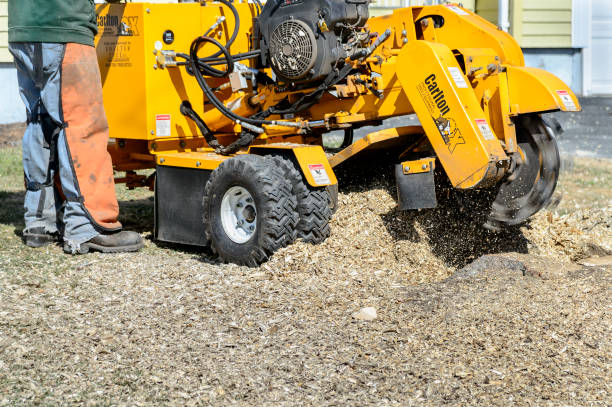When you leave tree stumps in your garden, you may unknowingly invite pests like termites and rodents. These decaying remnants attract unwanted visitors that can harm your plants and structures.
Stump grinding offers a solution by removing these potential pest havens, but the benefits go beyond eliminating stumps. Understanding how this process improves soil health and creates a more resilient garden environment is crucial.
You might be surprised by the additional advantages it brings.
The Connection Between Tree Stumps and Pests
Tree stumps may seem harmless, but they can serve as a breeding ground for various pests. The decaying wood in stumps offers an ideal habitat for termites, carpenter ants, and insects.
The moisture retention in the stump can also attract slugs, snails, and rodents, potentially leading to infestations in your home or garden. Addressing these risks before they escalate into more significant problems is essential.
Why Tree Stumps Attract Pests
- Termites and Carpenter Ants: The decaying wood in tree stumps provides an ideal environment for these wood-destroying pests.
- Rodents and Small Mammals: Stumps can act as shelters for small animals, increasing the risk of infestations.
- Moisture Retention: Moist, decaying wood attracts pests like slugs, snails, and beetles, damaging your plants and garden.
How Tree Stumps Lead to Home Infestations
- Pests Spreading to Your Home: Once pests like termites or ants find a home in the stump, they can easily make their way into your house, causing significant damage.
- Risk of Structural Damage: Termites and carpenter ants can destroy wood structures, compromising the safety and integrity of your home.
- Contamination: Pests from stumps can also carry bacteria, spreading illness to plants and humans.
How to Prevent Pest Problems
- Remove the Stump: The best way to prevent pests from residence is by removing the stump entirely.
- Regular Inspections: Inspect your yard for signs of pest activity around tree stumps and take immediate action if needed.
- Treat the Stump: If removal isn’t possible, treating the stump with pest control products can help prevent infestations.
Addressing tree stumps can protect your home and garden from future pest problems. Don’t wait for the pests to move in—act today!
Benefits of Stump Grinding for Soil Health
Stump grinding is not only about aesthetics; it also plays a key role in improving the health of your soil. When a tree stump is ground down, the resulting wood chips break into smaller pieces, allowing for easier decomposition.
This process adds valuable nutrients to the soil, fostering better plant growth and creating a healthier garden environment.
How Stump Grinding Improves Soil
- Nutrient Enrichment: As the wood decomposes, it releases important nutrients like nitrogen and carbon into the soil, benefiting your plants.
- Enhanced Soil Aeration: The grinding process improves soil structure, allowing for better water and air penetration, which is crucial for healthy root development.
- Reduced Soil Compaction: The broken wood particles help to loosen compacted soil, creating a more favorable environment for plant roots.
Long-Term Soil Health Benefits
- Better Water Retention: The decomposing wood increases the soil’s ability to retain moisture, reducing the need for frequent watering.
- Stronger Plant Growth: Improved aeration and nutrient-rich soil will help your plants experience stronger and more vibrant growth.
- Environmental Impact: Stump grinding reduces waste and recycles organic matter into the ecosystem, promoting sustainability.
Stump grinding offers long-lasting benefits that go beyond clearing your yard. It helps build a healthier soil environment that supports lush, thriving plants.
Creating a Pest-Free Garden Environment
Once you’ve taken steps to grind the stump and improve your soil, you’re setting the stage for a thriving, pest-free garden. Follow a few key strategies to ensure your garden remains healthy and protected from pests. By incorporating natural pest control and proactive measures, you can maintain a thriving garden without harsh chemicals.
Natural Ways to Keep Pests Away
- Plant Native Species: Native plants attract beneficial insects like ladybugs and lacewings, natural predators of harmful pests.
- Regular Inspections: Monitor your plants and immediately remove damaged or infested parts to prevent pests from spreading.
- Encourage Wildlife: Birds, frogs, and other wildlife can help keep pest populations in check, so create a welcoming environment for them.
Additional Measures for Pest Prevention
- Mulching: Apply mulch around plants to retain moisture and create a barrier against pests like ants and snails.
- Proper Drainage: Ensure your garden has good drainage to prevent standing water, which can attract mosquitoes and other pests.
- Organic Pest Control: Use natural treatments like neem oil or insecticidal soap to address pest problems without harming beneficial insects or the environment.
By taking these steps, you’ll create a balanced ecosystem where your plants can thrive and pests are kept at bay. A little effort now can result in a healthy, pest-resistant, and vibrant garden throughout the seasons.
Stump grinding offers a comprehensive solution that removes unsightly stumps, prevents pest infestations, and improves soil health. By eliminating potential breeding grounds for harmful insects and promoting healthier soil conditions, this service sets the foundation for a more resilient and thriving garden.
Taking proactive steps can protect your garden, home, and overall landscape from pest damage, ensuring a beautiful, pest-free environment for years.

